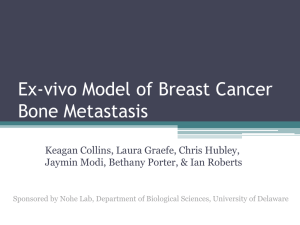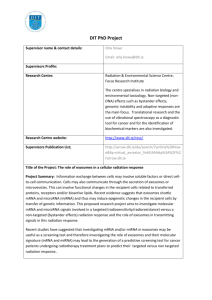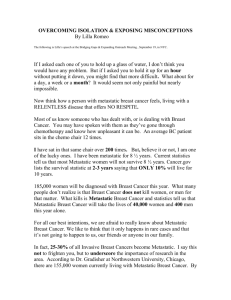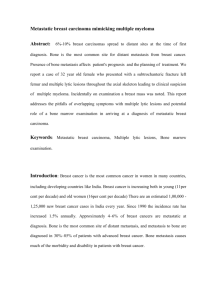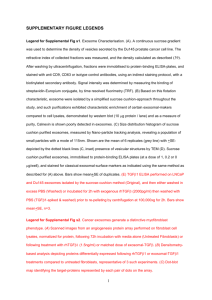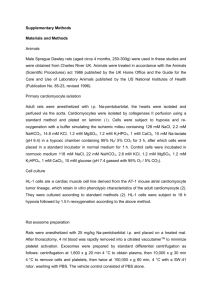Exosomes from bone marrow mesenchymal stem cells contain a
advertisement
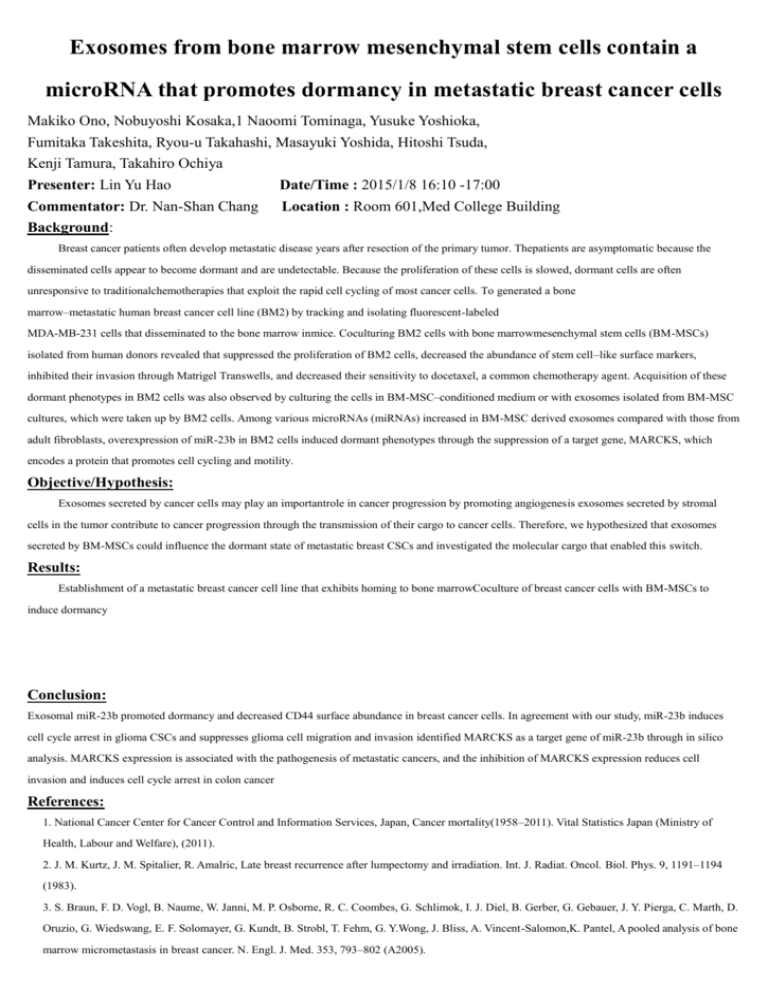
Exosomes from bone marrow mesenchymal stem cells contain a microRNA that promotes dormancy in metastatic breast cancer cells Makiko Ono, Nobuyoshi Kosaka,1 Naoomi Tominaga, Yusuke Yoshioka, Fumitaka Takeshita, Ryou-u Takahashi, Masayuki Yoshida, Hitoshi Tsuda, Kenji Tamura, Takahiro Ochiya Presenter: Lin Yu Hao Commentator: Dr. Nan-Shan Chang Background: Date/Time : 2015/1/8 16:10 -17:00 Location : Room 601,Med College Building Breast cancer patients often develop metastatic disease years after resection of the primary tumor. Thepatients are asymptomatic because the disseminated cells appear to become dormant and are undetectable. Because the proliferation of these cells is slowed, dormant cells are often unresponsive to traditionalchemotherapies that exploit the rapid cell cycling of most cancer cells. To generated a bone marrow–metastatic human breast cancer cell line (BM2) by tracking and isolating fluorescent-labeled MDA-MB-231 cells that disseminated to the bone marrow inmice. Coculturing BM2 cells with bone marrowmesenchymal stem cells (BM-MSCs) isolated from human donors revealed that suppressed the proliferation of BM2 cells, decreased the abundance of stem cell–like surface markers, inhibited their invasion through Matrigel Transwells, and decreased their sensitivity to docetaxel, a common chemotherapy agent. Acquisition of these dormant phenotypes in BM2 cells was also observed by culturing the cells in BM-MSC–conditioned medium or with exosomes isolated from BM-MSC cultures, which were taken up by BM2 cells. Among various microRNAs (miRNAs) increased in BM-MSC derived exosomes compared with those from adult fibroblasts, overexpression of miR-23b in BM2 cells induced dormant phenotypes through the suppression of a target gene, MARCKS, which encodes a protein that promotes cell cycling and motility. Objective/Hypothesis: Exosomes secreted by cancer cells may play an importantrole in cancer progression by promoting angiogenesis exosomes secreted by stromal cells in the tumor contribute to cancer progression through the transmission of their cargo to cancer cells. Therefore, we hypothesized that exosomes secreted by BM-MSCs could influence the dormant state of metastatic breast CSCs and investigated the molecular cargo that enabled this switch. Results: Establishment of a metastatic breast cancer cell line that exhibits homing to bone marrowCoculture of breast cancer cells with BM-MSCs to induce dormancy Conclusion: Exosomal miR-23b promoted dormancy and decreased CD44 surface abundance in breast cancer cells. In agreement with our study, miR-23b induces cell cycle arrest in glioma CSCs and suppresses glioma cell migration and invasion identified MARCKS as a target gene of miR-23b through in silico analysis. MARCKS expression is associated with the pathogenesis of metastatic cancers, and the inhibition of MARCKS expression reduces cell invasion and induces cell cycle arrest in colon cancer References: 1. National Cancer Center for Cancer Control and Information Services, Japan, Cancer mortality(1958–2011). Vital Statistics Japan (Ministry of Health, Labour and Welfare), (2011). 2. J. M. Kurtz, J. M. Spitalier, R. Amalric, Late breast recurrence after lumpectomy and irradiation. Int. J. Radiat. Oncol. Biol. Phys. 9, 1191–1194 (1983). 3. S. Braun, F. D. Vogl, B. Naume, W. Janni, M. P. Osborne, R. C. Coombes, G. Schlimok, I. J. Diel, B. Gerber, G. Gebauer, J. Y. Pierga, C. Marth, D. Oruzio, G. Wiedswang, E. F. Solomayer, G. Kundt, B. Strobl, T. Fehm, G. Y.Wong, J. Bliss, A. Vincent-Salomon,K. Pantel, A pooled analysis of bone marrow micrometastasis in breast cancer. N. Engl. J. Med. 353, 793–802 (A2005).




